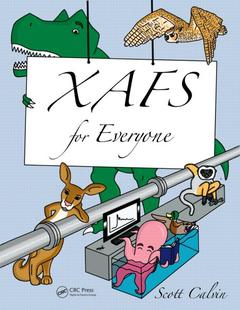Description
XAFS for Everyone
Author: Calvin Scott
Language: English
Subjects for XAFS for Everyone:
Keywords
XAFS Experiment; XANES Analysis; x-ray absorption fine-structure spectroscopy; XAFS Spectrum; XAFS experiments; EXAFS Oscillation; principal component analysis; EXAFS Signal; error analysis and statistical challenges in XAFS; EXAFS Region; XANES applications; XANES; EXAFS applications; Vice Versa; XAFS principles and analysis; EXAFS Spectrum; EXAFS Analysis; XAFS; Multiple Scattering Paths; EXAFS Fit; Edge Jump; Absorption Length; Theoretical Standards; Iron Shells; XANES Spectrum; Extended XAFS; Nitrate Ligands; Pre-edge Feature; Silicon Drift Detector; Target Transforms; LCF; Vanadium Atom
Approximative price 202.33 €
In Print (Delivery period: 13 days).
Add to cartPublication date: 04-2018
· 21.6x27.9 cm · Hardback
Publication date: 06-2013
· 21x28 cm · Paperback
Description
/li>Contents
/li>Readership
/li>Biography
/li>
XAFS for Everyone provides a practical, thorough guide to x-ray absorption fine-structure (XAFS) spectroscopy for both novices and seasoned practitioners from a range of disciplines. The text is enhanced with more than 200 figures as well as cartoon characters who offer informative commentary on the different approaches used in XAFS spectroscopy.
The book covers sample preparation, data reduction, tips and tricks for data collection, fingerprinting, linear combination analysis, principal component analysis, and modeling using theoretical standards. It describes both near-edge (XANES) and extended (EXAFS) applications in detail. Examples throughout the text are drawn from diverse areas, including materials science, environmental science, structural biology, catalysis, nanoscience, chemistry, art, and archaeology. In addition, five case studies from the literature demonstrate the use of XAFS principles and analysis in practice. The text includes derivations and sample calculations to foster a deeper comprehension of the results.
Whether you are encountering this technique for the first time or looking to hone your craft, this innovative and engaging book gives you insight on implementing XAFS spectroscopy and interpreting XAFS experiments and results. It helps you understand real-world trade-offs and the reasons behind common rules of thumb.
Scott Calvin is the chair of the Division of Natural Science and Mathematics at Sarah Lawrence College, where he teaches innovative courses, including crazy ideas in physics, rocket science, and steampunk physics. He is also a member of the principal research team for beamline X-11B at the National Synchrotron Light Source. Since 1998, he has been using XAFS to study systems as diverse as solar cells, magnetic nanoparticles, soil samples, battery cathodes, analogues to atmospheric dust particles, and pigments used in 18th century painting. He received a PhD in physics from Hunter College of the City University of New York.




